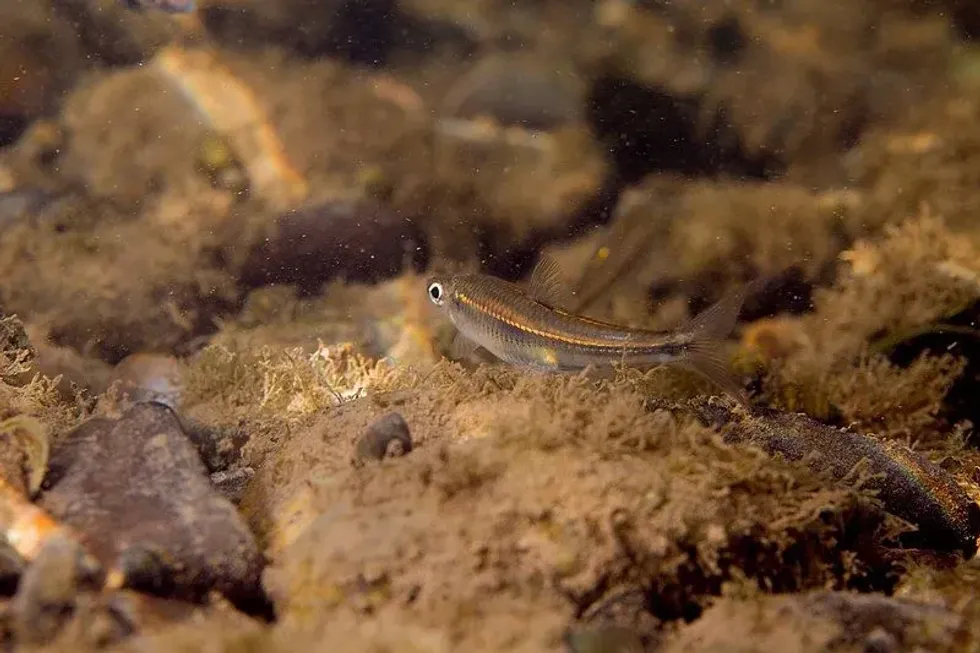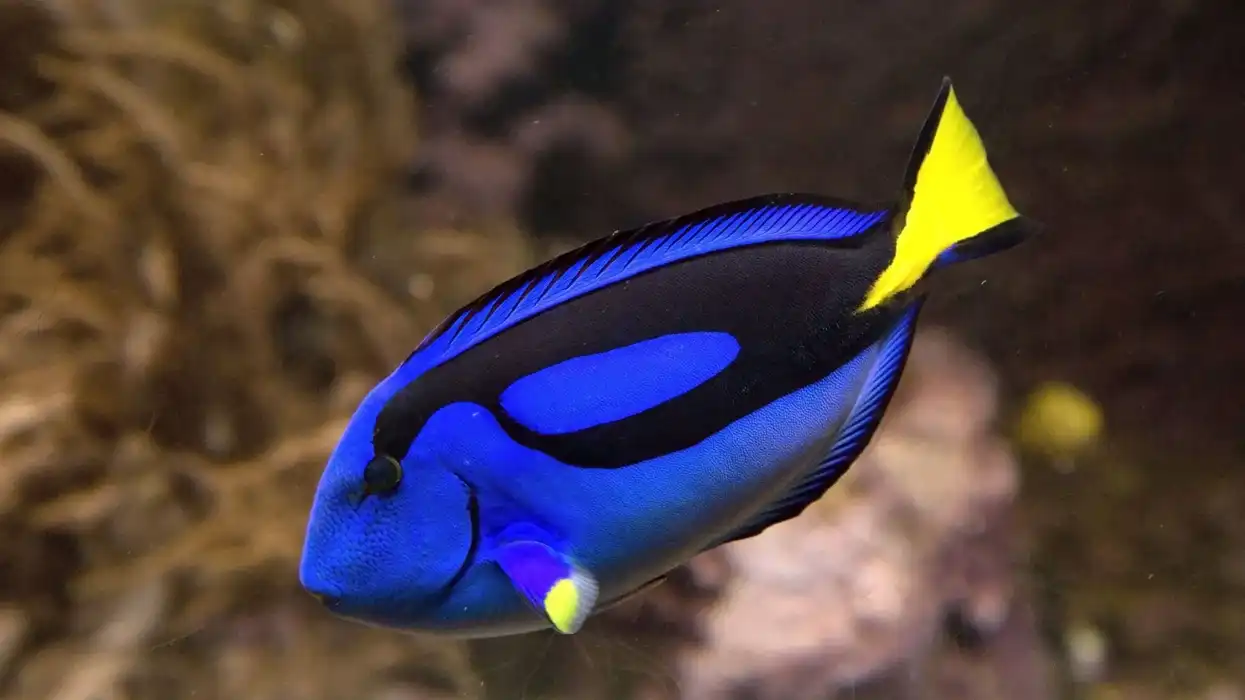The blacktail shiner (Cyprinella venusta), also called shiner minnow is freshwater fish species with a slender body of the family Cyprinidae and subfamily Pogonichthyinae. The genus Cyprinella is called satin fin shiners and consists of carps and minnows. The fishes of this genus are native species to North America and the southern United states.
Cyprinella is a Greek word meaning 'small carp,' and the specific term venusta is Latin which, means 'beautiful, like venus.' Numerous Cyprinella species are listed as Threatened.
There are currently around 32 described species in this genus. The blacktail shiners do not face population decline but, they face the threat of habitat destruction. These fishes have yellowish-olive backs and silvery sides.
There are three recognized subspecies of Cyprinella venusta, C. v. stigmature, C. v. venusta, and C. v. cercostigma. The primary diet of the blacktail shiners is invertebrates.
The members of the subfamily Pogonichthyinae are called North American clade minnows or American minnows. There are six subfamilies under Cyprinidae. In Illinois and texas, the black shiners hybridize with red shiners (C. lutrensis).
If these blacktail shiner facts are interesting, then do read about the white cloud mountain minnow and loach on our website!
Blacktail Shiner Interesting Facts
What type of animal is a blacktail shiner?
The blacktail shiner (Cyprinella venusta) has a slender body and a fish with a prominent black spot at the base of the tail fin 'black tail.' This fish belongs to the order Cypriniformes and phylum Chordata.
They are mostly found in sandy runs and pools. This fish also prefers freshwater and benthopelagic environments. This species is one of the most common and largest Cyprinella.
What class of animal does a blacktail shiner belong to?
The blacktail shiner (Cyprinella venusta) belongs to the Actinopterygii class of animals.
How many blacktail shiners are there in the world?
The exact population of the blacktail shiner (Cyprinella venusta) is not known. However, the adult population does exceed 100,000 and is probably more than 1,000,000.
Where does a blacktail shiner live?
The blacktail shiner (Cyprinella venusta) is a native of the southern united states.
It is found in the drainages of the Gulf of Mexico from Georgia, Florida, and the Suwannee river extending through the Rio Grande and Texas and also in the Mississippi river basin ranging from southern Illinois to Louisiana and from Red river drainage to west Oklahoma in the west.
It is found in the west of the Appalachian mountains in the southern U.S.
These species range west and east from west Texas to north-central Florida and southern Illinois in the north. They are primarily found from the Edwards plateau eastward in Texas.
Thye have also been reported in the Rio Grande basin, Suwannee river, and north through the Mississippi river basin coming together in the Ohio River.
Two subspecies are found in Alabama. C. v. stigmature or slender Blacktail shiner is found in the upper mobile river basin and C. v. cercostigma or the eastern Blacktail shiner is found in the lower mobile river basin and coastal rivers.
What is a blacktail shiner's habitat?
The blacktail shiner (Cyprinella venusta) is commonly found in sandy runs, pools, small-medium-sized rivers in regions with strong water currents and sparse vegetation. However, the upland population occupies creeks over the substrates with rubble, silt, bedrock, and gravel.
The western population occupies the turbid waters. They were most abundantly found in swift runs in summer and spring in Blanco River, Texas. In village creek, texas, they were found throughout the year in sandbank and riffle habitats
Who does blacktail shiner live with?
Cyprinella venusta lives in schools.
How long does a blacktail shiner live?
Cyprinella venusta lives up to four years of age in the Leaf river system, Mississippi, and up to five years of age in Blanco River, Texas.
How do they reproduce?
The spawning of these shiners is from April to September in Texas. Spawning is from late March to early October in Mississippi and most females are reproductive from April through September.
Some of these shiners found in Village creek in Texas had size distribution persistent with protracted spawning season. Fractional crevices are the spawning habitat situated in flowing water.
The blacktail shiners in Blanco River, Texas were observed to be depositing their eggs under large cobble and small boulders in bedrock riffles in high water velocities. Males are responsive to the spawning female's sounds and can easily differentiate these sounds from the red shiner females'.
The meals defend these crevices with eggs from other males. The eggs are usually deposited with viable sperm by the females.
Right after spawning, the male eats any eggs that would not make it into the crevice. Both small and large males enter the crevices of other males to deposit sperm before the start of courtship.
The female blacktail shiners had 340 ova and 139-459 ova found in the Blanco River, Texas and southwest Mississippi. In the Pearl River, Mississippi, the females laid 20-46 clutches in the reproductive season.
What is their conservation status?
The conservation status of the blacktail shiner fish is Least Concern. However, they face threats from habitat changes due to irrigation, flood control projects, drilling, mining, grazing, and hybridization.
Blacktail Shiner Fun Facts
What does a blacktail shiner look like?
The blacktails or shiners minnows have a slender body with a prominent black spot at the base of the tail fin and eight to nine rays on the anal fin. They have yellowish-olive backs and silvery sides with hints of blue.
These minnows can be differentiated from other minnow species with large black caudal spots. This spot on their body can be faint especially in turbid waters and can be confused with their relatives, red shiners (C. lutrensis).

*Please note that this is an image of a mimic shiner, a fish of the same family. If you have an image of the blacktail shiner please let us know at hello@kidadl.com.
How cute are they?
The prominent black spot at the base of the tail fin and bluish tint make these look beautiful. However, they are not considered cute.
How do they communicate?
These fishes communicate using acoustic signals, vision, and chemical release.
How big is a blacktail shiner?
The blacktail shiners can grow up to 4 in (100 mm). A study in the Leaf River system in Mississippi showed that at age one they grew up to 0.94 in (24 mm), age two up to 1.8 in (46 mm), age three up to 2.8 in (72 mm).
These adult species are an inch longer than their relatives, rainbow shiners which are 3 in (8 cm).
How fast can a blacktail shiner swim?
The exact swimming speed of the blacktail shiner fishes is not yet known.
How much does a blacktail shiner weigh?
The weight of these shiners is 0.2-0.4 lb (0.1-0.2 kg).
What are the male and female names of the species?
There are no specific names given to the male and female Blacktail shiner fishes.
What would you call a baby blacktail shiner?
There is no specific name given to the baby Blacktail shiner fishes. The babies are usually referred to as juveniles.
What do they eat?
The blacktail shiners feed on aquatic and terrestrial insects, algae, seeds, and invertebrates like shrimps, worms, and water beetles.
Are they dangerous?
No, these shiner species are not dangerous.
Would they make a good pet?
Yes, they would make a good pet.
Did you know...
A few other scientific names of the blacktail shiner are Notropis venustus and Notropis cooglei.
Cyprinella venusta or previously known as Notropis venustus has gained access to Ocmugee river drainage in Georgia but how and when is not known.
The black dot on their tail is a way to distinguish them from other minnows.
What kind of fish is a shiner?
The blacktail shiner (Cyprinella venusta) has a slender body and a fish with a prominent black spot at the base of the tail fin. These fishes are native species of the Southern United States in North America and prefer freshwater rivers.
What color is a shiner?
These shiner species have yellowish-olive backs and silvery sides with hints of blue. The most common shiner is the common shiner found in North America.
Here at Kidadl, we have carefully created lots of interesting family-friendly animal facts for everyone to discover! Learn more about some other fishes from our salmon facts and sturgeon facts pages.
You can even occupy yourself at home by coloring on one of our Blacktail Shiner coloring pages.
*Please note that the main image is of a striped shiner, a fish of the same order. If you have an image of the blacktail shiner please let us know at hello@kidadl.com.










